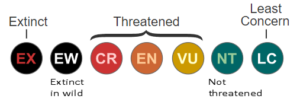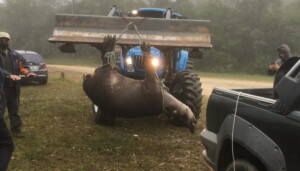What would you get if you crossed a pig with an elephant? Not literally of course, because that would be weird, but in terms of looks, a tapir fits the bill. In Brazil, calling someone a tapir is calling them a jackass, but funnily enough, donkeys are some of the closest relatives that tapirs have.
Page Contents
Background
There are four widely recognized extant species of tapir, all in the genus Tapirus. They are among the largest land mammals in the areas they are found.
| Name | Distribution * | Dimensions |
|---|---|---|
| Mayalan tapir/Asian tapir (black and white coat) | Indonesia, Malaysia, Myanmar, and Thailand | 250-300 cm head body length 280-400 kg weight |
| Mountain tapir/Wolly tapir (white lips) | Mountainous areas in Colombia, Ecuador, and the far north of Peru. | 180-200 cm head body length 150-200 kg weight |
| South American tapir/Lowland tapir (head/neck crest) | Parts of Venezuela, Colombia, and the Guianas, Brazil, Argentina, and Paraguay, Bolivia, Peru, and Ecuador | 191-242 cm head body length 180-300 kg weight |
| Baird's tapir/Central American tapir | Mexico, Central America and northwestern South America | 200-230 cm head body length 250-350 kg weight |
*Excellent interactive map of distributions can be found at Tapir Specialist Group
They can survive in a variety of habitats - woodlands, rainforests, mountains and grasslands, as long as good water sources are available.
These animals are strict herbivores, and forage from the forest floor and also can reach branches up to about 1.5 meters above ground. They use their prehensile snout to procure food and place it in their mouths. They are good swimmers and spend time grazing on water plants and can even use their snouts as snorkels if they are fully immersed e.g. if hiding from a predator such as a jaguar. They are eaten by jaguars, crocodiles, anacondas, and tigers.
They have a life span of about 30 years, are sexually mature at 2 years and a gestation period of about 13 months. Mothers nurse young for up to a year. Tapirs have a long reproductive cycle, having about 18 month intervals between births. Other than the mother/offspring relationship, tapirs are generally solitary.

Services
Ecology
Tapirs are keystone species in their communities. The tapir body shape features
- a robust frame
- barrel-shaped body
- rounded rear end
- tapering in the chest
so it is well adapted for crashing through dense vegetation while foraging.
[Tapirs move] great distances between various kinds of habitats as they travel from forest patch to forest patch, providing a functional link between them. They eat fruit in one place, swallow the seeds, walk long distances, and defecate on the way — dispersing seeds and creating a plant genetic flow between habitats. Many other animals play this role, but because tapirs eat enormous amounts of fruit, they distribute an enormous quantity of seeds. Forest structure and diversity would be very different without the presence of tapirs! 1
Tapirs are known as an “umbrella species” because they have a wide-ranging habitat that also includes wild cats, monkeys, deer, and many varieties of birds and reptiles. If we protect their habitat, the habitat of many other animals is also protected.2
Recent research has indicated that tapirs spend significant amounts of time in disturbed habitats because they are attracted to tender young shoots. One result of this is that tapirs have a significant role to play in re-afforestation efforts. Examination of tapir poop has indicated that very little of the seed that has passed through a tapir's digestive system is too damaged to germinate.
The tapir's foraging activities also make previously inaccessible food available to smaller animals. (This type of community activity is also seen in Australian drought periods when kangaroos dig for water, thus making it also accessible for other organisms which would otherwise miss out.)
Ecotourism
Tapirs are interesting to observe and juvenile tapirs are considered to rate high on the cuteness scale for humans. Hence the presence of tapirs in an area is an ecotourism advantage.
Summary of services provided for us
- Seed dispersal enabling biodiversity maintenance
- Aid in restoring damaged rainforest to fully diverse communities
- Make plant material available to other community members who would not have access in the absence of tapirs
- Recreational activities through ecotourism
- Services for ecosystem stability
Threats to the services?
Red List status of tapir species

- Baird's tapir - Endangered (Assessed 2014)
- Mountain tapir - Endangered (Assessed 2014)
- Malayan tapir - Endangered (Assessed 2014)
- Lowland tapir - Vulnerable (Assessed 2018)
Nature of threats

- Vehicular traffic - As they roam over relatively long distances, tapirs are at risk of becoming roadkill, especially as they are moving at times of the day when visibility is low.
- Land clearing - Land in the relevant areas is increasingly being cleared for agriculture.
- Hunting / Bad publicity - Tapirs have been hunted by humans for meat in some settings. Also, as tapirs are more and more likely to come across agricultural land, they are sometimes eliminated by humans because they are thought to cause crop damage.
What can we do to retain these services?
There are number of tapir focused conservation groups in existence e.g. the IUCN Tapir Specialist Group lists many initiatives including Mountain Tapir Conservation Project, and The Lowland Tapir Conservation Initiative,
The tourism industries in the countries where tapirs are found have been incentivised in some instances to promote ecotourism packages focused on tapir watching.
Dig deeper
- How Do You ReGrow a Rainforest? Send in the Tapirs
- Tapirs Status Survey and Conservation Action Plan
- Extinction of lowland tapir and white-lipped peccary would impair forest diversity
- Tapirs could be key in helping degraded rainforests bounce back
- For wildlife on Brazil’s highways, roadkill is just the tip of the iceberg







